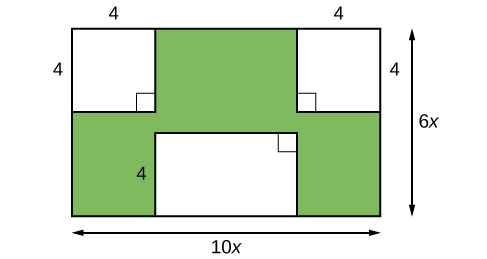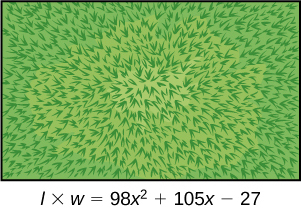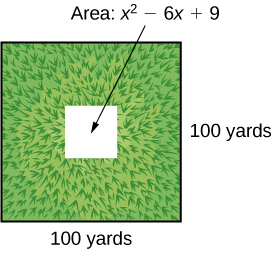
In this section students will:
Imagine that we are trying to find the area of a lawn so that we can determine how much grass seed to purchase. The lawn is the green portion in [link].

The area of the entire region can be found using the formula for the area of a rectangle.
The areas of the portions that do not require grass seed need to be subtracted from the area of the entire region. The two square regions each have an area of
units2. The other rectangular region has one side of length
and one side of length
giving an area of
units2. So the region that must be subtracted has an area of
units2.
The area of the region that requires grass seed is found by subtracting
units2. This area can also be expressed in factored form as
units2. We can confirm that this is an equivalent expression by multiplying.
Many polynomial expressions can be written in simpler forms by factoring. In this section, we will look at a variety of methods that can be used to factor polynomial expressions.
When we study fractions, we learn that the greatest common factor (GCF) of two numbers is the largest number that divides evenly into both numbers. For instance,
is the GCF of
and
because it is the largest number that divides evenly into both
and
The GCF of polynomials works the same way:
is the GCF of
and
because it is the largest polynomial that divides evenly into both
and
When factoring a polynomial expression, our first step should be to check for a GCF. Look for the GCF of the coefficients, and then look for the GCF of the variables.
The greatest common factor (GCF) of polynomials is the largest polynomial that divides evenly into the polynomials.
Given a polynomial expression, factor out the greatest common factor.
Factor
First, find the GCF of the expression. The GCF of
and
is
The GCF of
and
is
(Note that the GCF of a set of expressions in the form
will always be the exponent of lowest degree.) And the GCF of
and
is
Combine these to find the GCF of the polynomial,
Next, determine what the GCF needs to be multiplied by to obtain each term of the polynomial. We find that
and
Finally, write the factored expression as the product of the GCF and the sum of the terms we needed to multiply by.
After factoring, we can check our work by multiplying. Use the distributive property to confirm that
Factor
by pulling out the GCF.
Although we should always begin by looking for a GCF, pulling out the GCF is not the only way that polynomial expressions can be factored. The polynomial
has a GCF of 1, but it can be written as the product of the factors
and
Trinomials of the form
can be factored by finding two numbers with a product of
and a sum of
The trinomial
for example, can be factored using the numbers
and
because the product of those numbers is
and their sum is
The trinomial can be rewritten as the product of
and
A trinomial of the form
can be written in factored form as
where
and
Can every trinomial be factored as a product of binomials?
No. Some polynomials cannot be factored. These polynomials are said to be prime.
**Given a trinomial in the form
factor it.**
and
a pair of factors of
with a sum of
Factor
We have a trinomial with leading coefficient
and
We need to find two numbers with a product of
and a sum of
In [link], we list factors until we find a pair with the desired sum.
| Factors of | Sum of Factors |
|---|---|
| 14 | |
| 2 |
Now that we have identified
and
as
and
write the factored form as
We can check our work by multiplying. Use FOIL to confirm that
Does the order of the factors matter?
No. Multiplication is commutative, so the order of the factors does not matter.
Factor
Trinomials with leading coefficients other than 1 are slightly more complicated to factor. For these trinomials, we can factor by grouping by dividing the x term into the sum of two terms, factoring each portion of the expression separately, and then factoring out the GCF of the entire expression. The trinomial
can be rewritten as
using this process. We begin by rewriting the original expression as
and then factor each portion of the expression to obtain
We then pull out the GCF of
to find the factored expression.
To factor a trinomial in the form
by grouping, we find two numbers with a product of
and a sum of
We use these numbers to divide the
term into the sum of two terms and factor each portion of the expression separately, then factor out the GCF of the entire expression.
**Given a trinomial in the form
factor by grouping.**
and
a pair of factors of
with a sum of
Factor
by grouping.
We have a trinomial with
and
First, determine
We need to find two numbers with a product of
and a sum of
In [link], we list factors until we find a pair with the desired sum.
| Factors of | Sum of Factors |
|---|---|
| 29 | |
| 13 | |
| 7 |
So
and
We can check our work by multiplying. Use FOIL to confirm that
Factor a.
b.
a.
b.
A perfect square trinomial is a trinomial that can be written as the square of a binomial. Recall that when a binomial is squared, the result is the square of the first term added to twice the product of the two terms and the square of the last term.
We can use this equation to factor any perfect square trinomial.
A perfect square trinomial can be written as the square of a binomial:
Given a perfect square trinomial, factor it into the square of a binomial.
Factor
Notice that
and
are perfect squares because
and
Then check to see if the middle term is twice the product of
and
The middle term is, indeed, twice the product:
Therefore, the trinomial is a perfect square trinomial and can be written as
Factor
A difference of squares is a perfect square subtracted from a perfect square. Recall that a difference of squares can be rewritten as factors containing the same terms but opposite signs because the middle terms cancel each other out when the two factors are multiplied.
We can use this equation to factor any differences of squares.
A difference of squares can be rewritten as two factors containing the same terms but opposite signs.
Given a difference of squares, factor it into binomials.
Factor
Notice that
and
are perfect squares because
and
The polynomial represents a difference of squares and can be rewritten as
Factor
Is there a formula to factor the sum of squares?
No. A sum of squares cannot be factored.
Now, we will look at two new special products: the sum and difference of cubes. Although the sum of squares cannot be factored, the sum of cubes can be factored into a binomial and a trinomial.
Similarly, the sum of cubes can be factored into a binomial and a trinomial, but with different signs.
We can use the acronym SOAP to remember the signs when factoring the sum or difference of cubes. The first letter of each word relates to the signs: Same Opposite Always Positive. For example, consider the following example.
The sign of the first 2 is the same as the sign between
The sign of the
term is opposite the sign between
And the sign of the last term, 4, is always positive.
We can factor the sum of two cubes as
We can factor the difference of two cubes as
Given a sum of cubes or difference of cubes, factor it.
or
For a difference of cubes, write the factored form as
Factor
Notice that
and
are cubes because
Rewrite the sum of cubes as
After writing the sum of cubes this way, we might think we should check to see if the trinomial portion can be factored further. However, the trinomial portion cannot be factored, so we do not need to check.
Factor the sum of cubes:
Factor
Notice that
and
are cubes because
and
Write the difference of cubes as
Just as with the sum of cubes, we will not be able to further factor the trinomial portion.
Factor the difference of cubes:
Expressions with fractional or negative exponents can be factored by pulling out a GCF. Look for the variable or exponent that is common to each term of the expression and pull out that variable or exponent raised to the lowest power. These expressions follow the same factoring rules as those with integer exponents. For instance,
can be factored by pulling out
and being rewritten as
Factor
Factor out the term with the lowest value of the exponent. In this case, that would be
Factor
Access these online resources for additional instruction and practice with factoring polynomials.
| difference of squares |
| perfect square trinomial |
| sum of cubes |
| difference of cubes |
If the terms of a polynomial do not have a GCF, does that mean it is not factorable? Explain.
The terms of a polynomial do not have to have a common factor for the entire polynomial to be factorable. For example,
and
don’t have a common factor, but the whole polynomial is still factorable:
A polynomial is factorable, but it is not a perfect square trinomial or a difference of two squares. Can you factor the polynomial without finding the GCF?
How do you factor by grouping?
Divide the
term into the sum of two terms, factor each portion of the expression separately, and then factor out the GCF of the entire expression.
For the following exercises, find the greatest common factor.
For the following exercises, factor by grouping.
For the following exercises, factor the polynomial.
For the following exercises, factor the polynomials.
For the following exercises, consider this scenario:
Charlotte has appointed a chairperson to lead a city beautification project. The first act is to install statues and fountains in one of the city’s parks. The park is a rectangle with an area of
m2, as shown in the figure below. The length and width of the park are perfect factors of the area.

Factor by grouping to find the length and width of the park.
A statue is to be placed in the center of the park. The area of the base of the statue is
Factor the area to find the lengths of the sides of the statue.
At the northwest corner of the park, the city is going to install a fountain. The area of the base of the fountain is
Factor the area to find the lengths of the sides of the fountain.
For the following exercise, consider the following scenario:
A school is installing a flagpole in the central plaza. The plaza is a square with side length 100 yd. as shown in the figure below. The flagpole will take up a square plot with area
yd2.

Find the length of the base of the flagpole by factoring.
For the following exercises, factor the polynomials completely.
by dividing the x term into the sum of two terms, factoring each portion of the expression separately, and then factoring out the GCF of the entire expression

You can also download for free at http://cnx.org/contents/13ac107a-f15f-49d2-97e8-60ab2e3b519c@11.1
Attribution: